Related Research Articles
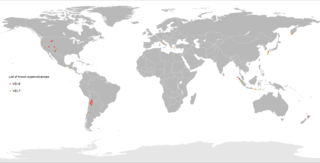
A supervolcano is a volcano that has had an eruption with a volcanic explosivity index (VEI) of 8, the largest recorded value on the index. This means the volume of deposits for such an eruption is greater than 1,000 cubic kilometers.

Mount Erebus is the second-highest volcano in Antarctica, the highest active volcano in Antarctica, and the southernmost active volcano on Earth. It is the sixth-highest highest point of an island, and the second most prominent mountain in Antarctica after Mount Vinson. It has a summit elevation of 3,794 metres (12,448 ft). It is located in the Ross Dependency on Ross Island, which is also home to three inactive volcanoes: Mount Terror, Mount Bird, and Mount Terra Nova. The mountain was named by Captain James Clark Ross in 1841 for his ship, the Erebus.

Volcanology is the study of volcanoes, lava, magma and related geological, geophysical and geochemical phenomena (volcanism). The term volcanology is derived from the Latin word vulcan. Vulcan was the ancient Roman god of fire.

A volcanologist, or volcano scientist, is a geologist who focuses on understanding the formation and eruptive activity of volcanoes. Volcanologists frequently visit volcanoes, sometimes active ones, to observe and monitor volcanic eruptions, collect eruptive products including tephra, rock and lava samples. One major focus of inquiry in recent times is the prediction of eruptions to alleviate the impact on surrounding populations and monitor natural hazards associated with volcanic activity. Geologists who research volcanic materials that make up the solid Earth are referred to as igneous petrologists.

Catherine Joséphine "Katia" Krafft and her husband, Maurice Paul Krafft were French volcanologists and filmmakers who died in a pyroclastic flow on Mount Unzen, Nagasaki, Japan, on 3 June 1991. The Kraffts became well known as pioneers in the filming, photographing, and recording of volcanoes, often coming within feet of lava flows. Their obituary appeared in the Bulletin of Volcanology. Since their deaths, their work has been featured in two documentary films by Werner Herzog, Into the Inferno (2016) and The Fire Within: A Requiem for Katia and Maurice Krafft (2022), and a further film, Fire of Love (2022), depicted their lives, relationship and careers using their archived footage.
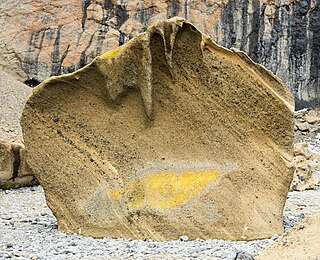
Tephra is fragmental material produced by a volcanic eruption regardless of composition, fragment size, or emplacement mechanism.
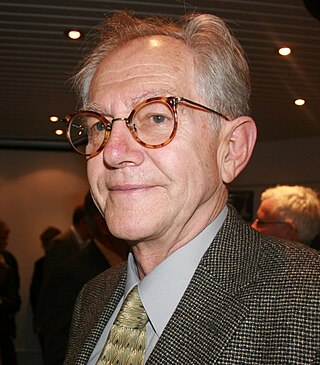
Haraldur Sigurðsson or Haraldur Sigurdsson is an Icelandic volcanologist and geochemist.

In volcanology, a Strombolian eruption is a type of volcanic eruption with relatively mild blasts, typically having a Volcanic Explosivity Index of 1 or 2. Strombolian eruptions consist of ejection of incandescent cinders, lapilli, and volcanic bombs, to altitudes of tens to a few hundreds of metres. The eruptions are small to medium in volume, with sporadic violence. This type of eruption is named for the Italian volcano Stromboli.

Peter William Francis (1944–1999) was a British volcanologist specialising in the study of active volcanoes on both the Earth and other planets in the Solar System. He was also renowned for his ability as a communicator, reaching the general public in a series of popular and acclaimed books on his subject.

Lake Ilopango is a crater lake which fills an 8 by 11 km volcanic caldera in central El Salvador, on the borders of the San Salvador, La Paz, and Cuscatlán departments. The caldera, which contains the second largest lake in the country and is immediately east of the capital city, San Salvador, has a scalloped 100 m (330 ft) to 500 m (1,600 ft) high rim. Any surplus drains via the Jiboa River to the Pacific Ocean. The local military airbase, Ilopango International Airport, has annual airshows where international pilots from all over the world fly over San Salvador City and Ilopango lake.
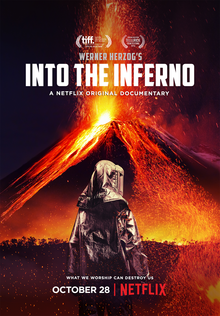
Into the Inferno is a 2016 documentary film directed by Werner Herzog. In it, Herzog and volcanologist Clive Oppenheimer explore active volcanoes around the world, especially how they have impacted the cultures of the people who live near them. The film had its world premiere at the 43rd Telluride Film Festival on 3 September 2016 before it began streaming on Netflix on 28 October.

A multi-component gas analyzer system (Multi-GAS) is an instrument package used to take real-time high-resolution measurements of volcanic gases. A Multi-GAS package includes an infrared spectrometer for CO2, two electrochemical sensors for SO2 and H2S, and pressure–temperature–humidity sensors, all in a weatherproof box. The system can be used for individual surveys or set up as permanent stations connected to radio transmitters for transmission of data from remote locations. The instrument package is portable, and its operation and data analysis are simple enough to be conducted by non-specialists.
Kayla Iacovino is an American volcanologist, noted for her widespread fieldwork and experimental petrology. She was the first woman to do her field work in North Korea. Originally from Arizona in the United States, she has worked in countries including Chile, North Korea, China, Costa Rica, Antarctica, Italy, Japan and Ethiopia.
Marie Edmonds is a Professor of volcanology and Earth Sciences at the Department of Earth Sciences at the University of Cambridge whose research focuses on the physics and chemistry of volcanic eruptions and magmatism and understanding volatile cycling in the solid Earth as mediated by plate tectonics. She is interested in the social and economic impacts of natural hazards; and the sustainable use of Earth's mineral and energy resources. Professor Edmonds is the Vice President and Ron Oxburgh Fellow in Earth Sciences at Queens' College, Cambridge; and the Deputy Head of Department and Director of Research at the Earth Sciences Department, University of Cambridge.
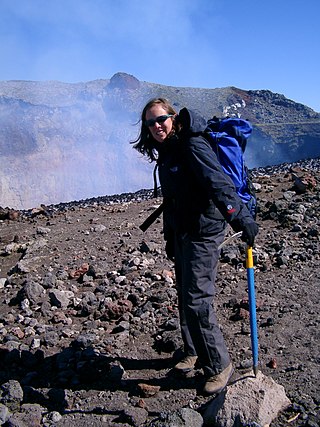
Tamsin Alice Mather is a British Professor of Earth Sciences at the Department of Earth Sciences, University of Oxford and a Fellow of University College, Oxford. She studies volcanic processes and their impacts on the Earth's environment and has appeared on the television and radio.

A fumarolic ice tower is a tower of ice produced by fumaroles of volcanic activity in an environment whose ambient temperature is below the freezing point of water. They are often underlain by large ice caves.

Hazel Rymer is a British volcanologist and Pro-Vice Chancellor at the Open University. Her research investigates how active volcanoes affect their environment and impact global climate change. She leads the citizen science project Earth Watch.
Jenni Barclay is a professor of volcanology at the University of East Anglia. She works on ways to mitigate volcanic risks, the interactions between rainfall and volcanic activity and the communication of volcanic hazards in the Caribbean. Barclay leads the NERC-ESRC funded Strengthening Resilience to Volcanic Hazards (STREVA) research project as well as a Leverhulme Trust programme looking at the volcanic history of the Ascension Islands.
References
- 1 2 3 Oppenheimer, Clive (2011). Eruptions that Shook the World. Cambridge: Cambridge University Press. doi:10.1017/CBO9780511978012. ISBN 978-0521641128.
- 1 2 3 4 5 Clive Oppenheimer publications indexed by Google Scholar
- 1 2 3 Oppenheimer, Clive (1991). Volcanology from space : applications of infrared remote sensing. jisc.ac.uk (PhD thesis). Open University. OCLC 59919963. EThOS uk.bl.ethos.293718. Archived from the original on 24 July 2018. Retrieved 27 August 2017.

- 1 2 3 4 5 "Clive Oppenheimer BA PhD". cam.ac.uk. University of Cambridge. Department of Geography. Retrieved 27 August 2017.
- ↑ Klemetti, Erik (26 July 2011). "Q&A: Dr. Clive Oppenheimer answers your questions!". wired.com. Retrieved 27 August 2017.
- ↑ Mather, T.A.; Tsanev, V.I.; Pyle, D.M.; McGonigle, A.J.S.; Oppenheimer, C.; Allen, A. G. (2004). "Characterization and evolution of tropospheric plumes from Lascar and Villarrica volcanoes, Chile". Journal of Geophysical Research: Atmospheres. 109 (D21): D21303. Bibcode:2004JGRD..10921303M. doi: 10.1029/2004JD004934 .
- ↑ "Department of Geography, Cambridge » Clive Oppenheimer". www.geog.cam.ac.uk. Retrieved 13 August 2022.
- ↑ Francis, P.; Horrocks, L.; Oppenheimer, C. (2000). "Monitoring gases from andesite volcanoes". Philosophical Transactions of the Royal Society A: Mathematical, Physical and Engineering Sciences. 358 (1770): 1567–1584. Bibcode:2000RSPTA.358.1567F. doi:10.1098/rsta.2000.0604. ISSN 1364-503X. S2CID 140709631.
- ↑ Galle, Bo; Oppenheimer, Clive; Geyer, Andreas; McGonigle, Andrew J.S; Edmonds, Marie; Horrocks, Lisa (2003). "A miniaturised ultraviolet spectrometer for remote sensing of SO₂ fluxes: a new tool for volcano surveillance". Journal of Volcanology and Geothermal Research. 119 (1–4): 241–254. Bibcode:2003JVGR..119..241G. doi:10.1016/S0377-0273(02)00356-6. ISSN 0377-0273.
- ↑ "HSM 89: Terra Nova Expedition 1910-12, Upper "Summit Camp" used during survey of Mount Erebus in December 1912". Antarctic Treaty Secretariat. Retrieved 27 August 2017.
- ↑ "HSM 90: Terra Nova Expedition 1910-12, Lower "Camp E" Site used during survey of Mount Erebus in December 1912". Antarctic Treaty Secretariat. Retrieved 27 August 2017.
- ↑ "Rumbling volcano sees N. Korea warm to the West". CBS News . 16 September 2014.
- ↑ Hammond, James (9 February 2016). "Understanding Volcanoes in Isolated Locations". Science & Diplomacy. 5 (1).
- ↑ "The Museum of Curiosity: Series 11, Episode 5". BBC Radio 4. Retrieved 27 August 2017.
- ↑ "Volcanoes, Series 17, The Infinite Monkey Cage - BBC Radio 4". BBC.
- ↑ "List and Description" (PDF). rgs.org. Royal Geographical Society. Archived from the original (PDF) on 27 August 2017. Retrieved 27 August 2017.
- ↑ "Recipients 1970-2016" (PDF). Medals and Awards. Royal Geographical Society. Archived from the original (PDF) on 27 August 2017. Retrieved 27 August 2017.
- ↑ Clive Oppenheimer publications indexed by the Scopus bibliographic database. (subscription required)
- ↑ Witze, Alexandra (29 July 2011). "BOOK REVIEW: Eruptions That Shook the World by Clive Oppenheimer". Science News. Retrieved 27 August 2017.
- ↑ Debruge, Peter (5 September 2016). "Film Review: 'Into the Inferno'". Variety. Retrieved 27 August 2017.
- ↑ Grove, Jack (20 October 2016). "The volcanologist who led Werner Herzog into the inferno". timeshighereducation.com. Times Higher Education . Retrieved 27 August 2017.
- ↑ "John Gribbin - Flames Beneath His Feet". Literary Review. 24 January 2024. Retrieved 24 January 2024.
- ↑ Volcanoes by Peter Francis and Clive Oppenheimer (2nd ed, 2004, Oxford UP ISBN 978-0199254699)
- ↑ Volcanism and the Earth's Atmosphere edited by Alan Robock and Clive Oppenheimer, (2004, Wiley ISBN 978-0875909981)
- ↑ Volcanic Degassing by Clive Oppenheimer, D.M. Pyle, J. Braclay (2003, Geological Society ISBN 9781862391369)